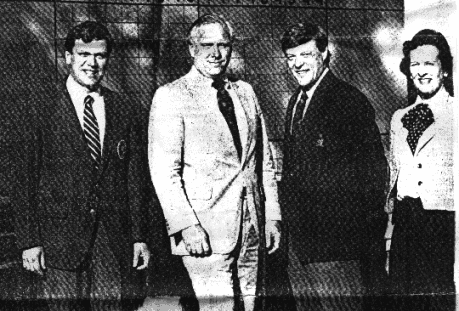|
They'll Know the Score at TCC

The US Golf Association's Dean Knuth (left), who is in charge of scoring for the US Open at The Country Club, will get plenty of help from the host club's (from left) Roger Scovell, Ed White and Cindi Evans, who have arranged what Knuth calls "the best setup of any USGA tournament ever."
By Paul Harber Globe Staff
Dean Knuth, the master mathematician of the US Golf Association, was asked by Roger Scovell of The Country Club, "What, in your wildest dreams, would you like to have to facilitate scorekeeping at the US Open this June?
The 41-year-old Knuth, who is in charge of scoring for the event, answered, "I told them I'd like a video camera pointed at the monster scoreboard at the 18th green." And he got it.
When Knuth sits at Command Central on the second floor of the press room, he can look at every score being put up on the monster board. And they are the same boards that were used at the Olympic Club in San Francisco last year.
"This is the best setup for the media and for scoring of any tournament in the history of the USGA," said Knuth, who has worked more than a few tournaments in his time. "The Country Club has bent over backward." But the key to scoring at the US Open will not be a hot putter or an accurate iron. It will be Unisys.
Unisys?
No, that isn't a square-grooved fourth wedge or the leading golfer on the Asian Order of Merit. It is a Michigan-based high-tech company that will provided split-second computerized scoring.
But the computer will need help. There will1 be more than 540 volunteers. Some will walk the course as scorers or standard-bearers, others will be stationed at every hole to tabulate the scores. Still others will man the 14 scoreboards spread over the course.
The state-of-the-art technology costs approximately $1 million and requires 75 terminals that are spread to every significant site, including the hospitality tents.
"This is the largest computerized scoring system we've installed for golf," said Bruce Gould, a spokesman for Unisys.
This is the fourth straight US Open for Unisys.
"We have been doing the British Open since 1980," said Gould, "and the USGA saw what we could do. When the US Open came to Oakland Hills In Birmingham, Mich., near our headquarters, we were first brought in and have been with them ever since."
Unisys was involved in the scoring for the 1979 PGA Championship at Oakland Hills and will be scoring for the PGA Championship this summer in Oklahoma for the third time. Last month Unisys worked its first Memorial Tournament..
"We're not in the golf scoring business," said Gould, "and we get no money out of this, but we do get our name across to a lot of important people."
Gould and Knuth have been in contact with The Country Club's scoring committee, headed by Scovell and Ed White, for more than a year, coordinating the scoring system.
Last fall Knuth came to Brookline for initial meetings with the committee and in April his slide show on scoring was shown to volunteers. Knuth and Gould are currently in town to go over last-minute details.
The first phase of gathering results comes from the 60 walkers recruited to follow the golfers for all 18 holes, recording their strokes.
The walkers are usually female, an old custom, usually low-handicap golfers who walk when they play.
The walkers fill out a "ticket" on how those in their group played a hole and hand it to a "greens communicator." Although there are only 18 holes, there are 20 greens communicators, two extra in case of emergencies.
The greens communicators then telephone the scoring team and pass the figures along to "hole score receivers." The hole score receivers must then repeat the scores they are given and the greens communicators must say, "That is correct."
The numbers are then entered into the computer.
"For the first time we will-have three roving, supervising scorers, one for the first six holes, another for 7 through 12 and the third for 13 through 18," said Knuth. It will be a way of limiting mistakes.
Knuth says there are usually 20 scoring errors during the first two days of the US Open and 10 a day for the last two.
"Ninety percent of the errors come from misinterpretations of the rules by the walking scorers," said Knuth. "They are not sure if a player is to take a penalty stroke or not. That's where most of the mistakes occur."
Scovell, who has been involved in scoring before, says he "was recruited by (tournament director) Kenny Burnes in the fall of 1985. I really haven't done anything for the club in the past, so I figured it was time to help out."
Scovell has had plenty of help from White, a member of the general committee in charge of administration, and Cindi Evans.
"I never would have believed, after watching golf on television, what goes on behind the scenes," he said. "For a four-day event, it takes 2,000 volunteers and three years of planning."
"Every day you can feel the excitement grow. It is a once-in-a-lifetime opportunity, and we are all glad to be a part of it."
|






